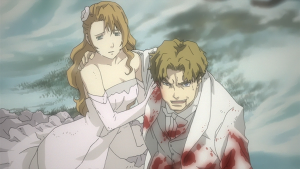Baccano
November 13, 2015 · 0 comments
By Andy Hanley
 “There is one incident, but there are as many stories about it as there are people involved”
“There is one incident, but there are as many stories about it as there are people involved”
If you wanted to sum up Baccano in a single sentence, then this quote from its opening episode is as succinct a description of the series as you could hope for. At its core, much of Baccano revolves around a single incident – an ever-more complex web of conflicting groups and interests aboard the Flying Pussyfoot (no giggling at the back), a train travelling from Chicago to New York – but such is the variety of characters involved or inadvertently caught up in events that there are myriad stories to be told and woven into a richer narrative from this single train journey.
The first episode of the series also sets the scene for what to except from the show in other senses, as a reporter and his assistant discuss the strange events which they’re investigating – the very same events we’re about to see play out before us. Where does this story begin exactly? Who is the main character? These topics are playfully discussed to give at least some hints as to the kind of sprawling story-telling to expect from this adaptation of Ryohgo Narita’s light novels.
Baccano’s unique manner of telling a story is matched by an equally unique setting – eschewing Tokyo or a Japanese high school as the backdrop to the series, Baccano instead pulls us into 1930s New York; a time of Prohibition and conflict between various Mafia gangs, which gives the series plenty of interesting subject matter. This also affords the show an incredibly eye-catching aesthetic – it makes the most of the grandiose architecture and industry of its setting (topped off by the overblown opulence of the Flying Pussyfoot) to provide a wonderful backdrop to events, and this is further evoked by the use of colour throughout the series which invokes the period in question to a tee.
 The grandiose setting isn’t given too much time to steal the scene; not with so many larger than life characters to catch the eye, whether it’s the murderous Ladd Russo or the comic relief duo of Isaac and Miria (watch out for their cameo in the Durarara anime, too). Indeed, even the names of members of the show’s cast immediately catch the eye – where else will you find an individual named Jacuzzi Splot, for example? That such a large cast of compelling (and frequently psychotic) characters can fit into a single story so effortlessly and naturally is the best possible example of the magic that Baccano weaves to create such a memorable series.
The grandiose setting isn’t given too much time to steal the scene; not with so many larger than life characters to catch the eye, whether it’s the murderous Ladd Russo or the comic relief duo of Isaac and Miria (watch out for their cameo in the Durarara anime, too). Indeed, even the names of members of the show’s cast immediately catch the eye – where else will you find an individual named Jacuzzi Splot, for example? That such a large cast of compelling (and frequently psychotic) characters can fit into a single story so effortlessly and naturally is the best possible example of the magic that Baccano weaves to create such a memorable series.
Speaking of magic, and much like the subsequent Durarara, there is a supernatural element to Baccano, this time revolving around alchemy and an attempt to attain that age-old Holy Grail of medicine that is immortality. This serves as essentially the final piece in the show’s jigsaw, providing motivations, plot twists and opportunities to raise the stakes as and when the story requires it.
A unique series in terms of both its setting and narrative ambition, Baccano also remains perhaps the quintessential example of how to handle an ensemble cast within an anime series – the result is both a cult classic amongst anime fans and a gripping, entertaining series that will repay every minute of time which you invest in it.
Andy Hanley is editor-in-chief of the UK Anime Network. Baccano is available on Blu-ray from Anime Limited.
Leave a Reply